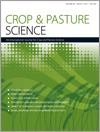CP17126Differential nitrogen supply causes large variability in photosynthetic traits in wheat germplasm
This study evaluated variation in photosynthetic parameters at various growth stages in 43 wheat genotypes under optimal and low nitrogen supply. Based on all studied parameters, a dissimilarity matrix was constructed, separating the 43 genotypes into groups. Some genotypes appear to have relative tolerance to low nitrogen supply and a potential to be used in discerning the molecular basis of tolerance to low nitrogen supply.




